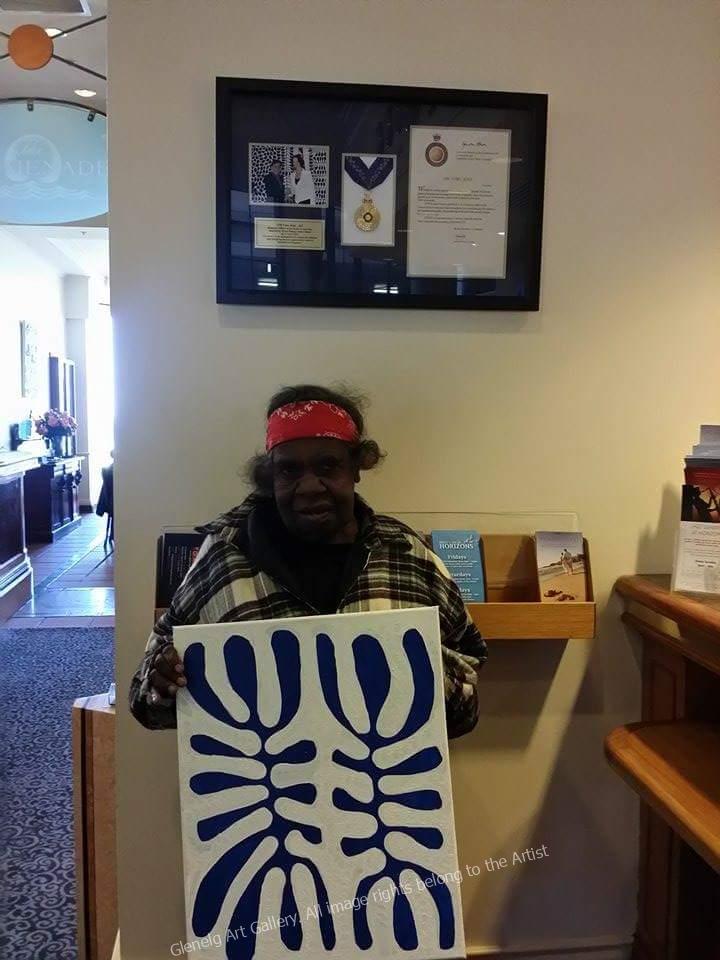Mitjili Napurrula
1945 – 2019
Mitjili was born at Haasts Bluff, after her mother’s Pintupi/Luritja family came in from the desert seeking refuge and rations, Mitjili Napurrula grew up in Papunya and later married the artist, Long Tom Tjapanangka.
With their extended family, they returned to Haasts Bluff as part of the 1980’s outstation movement and both artists, often in conjunction, proceeded to contribute significantly to the emerging art community there. Under the guidance of art coordinator Marina Strocchi, Ikuntji Art Centre rapidly developed an exciting style of its own, propelled in part by the older women who had been assistants to Geoffrey Bardon’s first painting men at Papunya.
Mitjili Napurrula began painting in 1992, encouraged by the opening of the Ikuntji Women’s Centre, the social and artistic hub of Haasts Bluff and nearby desert communities.
Coming from a family of distinguished artists, including her mother Tjunkiya Napaltjarri and her brother Turkey Tolson Tjupurrula, she grew up watching artists paint during the formative period of the western desert art movement.
Tjunkiya, who became one of the foundation group of female artists to take up painting following the joint Kintore/Haasts Bluff painting project in 1994, passed on the Pintupi symbolic language of her father’s tradition to her daughter Mitjili, by relating stories to her as she drew in the sand.
Over a few years Mitjili developed her own distinctive painting style and gained an international following after winning the Alice Springs Art Prize in 1999.
By then she had developed her own naturalistic approach to painting.
In the process of gradually reducing the complexity of her imagery she worked toward creating a tapestry of repeated shapes and symbols that convey a personal vision and individual style.
Her singularly distinctive iconography may be highlighted through the dazzling combination of strong complimentary tones or, alternatively, as in this striking example, may just as easily be depicted in the stark juxtaposition of two contrasting colors.
This image is based on her father’s country at Uwalki, where red sandhills, native grasses and wiry trees stretch to the horizon’s edge. The beautiful desert oak, Watiya Tjuta, one of the artist’s more familiar motifs creates a vibratory pattern that appeals to a modern sensibility when realized in such startling contrast.
Like her famous brother Turkey Tolson, Mitjili inherited the right to paint Ilyingaungau, a site in the Gibson Desert where the ancestors prepared their spears (kulata).
Turkey’s iconic Spear Straightening paintings should be seen as the complimentary balance with his sister’s feminine rendition of the plants and places associated with the cutting of wood and assembling of spears.
Watiya Tjuta by Mitjili Napurrula

We met Mitjili with Deb McDonald Nangala, and they both painted with us sometimes when they were in Adelaide, and stayed with us.
Mitjili’s distinctive style is based on her father’s country, also called Uwalki, an area west of Haasts Bluff near the Kintore Ranges in central Australia.
Characterised by red sand-hills, bushes and trees it is here that the spearwood trees used to make spears, are found. As custodian of the Kulata Tjurrkupa (Spear Dreaming) and representing the female side of the Dreaming, Mitjili depicts the trees (Watiya Tjuta) which provide the wood for the spears, whilst her brother is well known for painting the stories associated with making and assembling the spears. Mitjili husband Long Tom Tjapanangka (passed away) was also an accomplished artist.
IT IS A LOVE STORY.
Come and let us share it with you.
Please enquire if interested in the last of Mitjili’s work we have available. Her long companion in two women travelling, Debra has inherited Mitjili’s Stories and will be painting with us again in 2021
MIliji at the Stamford Grand Hotel Glenelg, along from the Gallery. The photograph behind Mitjili is of the then Prime Minister Julia Gillard with the Chairmen of Stamford International in front of one of Mitjili’s paintings at the ceremony

Mitjili Napurrula began painting in 1992, encouraged by the opening of the Ikuntji Women’s Centre, the social and artistic hub of Haasts Bluff and nearby desert communities. Coming from a family of distinguished artists, including her mother Tjunkiya Napaltjarri and her brother Turkey Tolson Tjupurrula, she grew up watching artists paint during the formative period of the western desert art movement. Tjunkiya, who became one of the foundation group of female artists to take up painting following the joint Kintore/Haasts Bluff painting project in 1994, passed on the Pintupi symbolic language of her father’s tradition to her daughter Mitjili, by relating stories to her as she drew in the sand. While it took a few years before she developed her own distinctive painting style Mitjili gained an international following after winning the Alice Springs Art Prize in 1999. By then she had developed her own naturalistic approach to painting.
In the process of gradually reducing the complexity of her imagery she worked toward creating a tapestry of repeated shapes and symbols that convey a personal vision and individual style. Her singularly distinctive iconography may be highlighted through the dazzling combination of strong complimentry tones or, alternatively, as in this striking example, may just as easily be depicted in the stark juxtaposition of two contrasting colors.
This image is based on her father’s country at Uwalki, where red sandhills, native grasses and wiry trees stretch to the horizon’s edge. The beautiful desert oak, Watiya Tjuta, one of the artist’s more familiar motifs creates a vibratory pattern that appeals to a modern sensibility when realized in such startling contrast.
Like her famous brother Turkey Tolson, Mitjili inherited the right to paint Ilyingaungau, a site in the Gibson Desert where the ancestors prepared their spears (kulata). Turkey’s iconic Spear Straightening paintings should be seen as the complimentary balance with his sister’s feminine rendition of the plants and places associated with the cutting of wood and assembling of spears.
